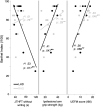Motor Deficits in the Ipsilesional Arm of Severely Paretic Stroke Survivors Correlate With Functional Independence in Left, but Not Right Hemisphere Damage
- PMID: 33362495
- PMCID: PMC7756120
- DOI: 10.3389/fnhum.2020.599220
Motor Deficits in the Ipsilesional Arm of Severely Paretic Stroke Survivors Correlate With Functional Independence in Left, but Not Right Hemisphere Damage
Abstract
Chronic stroke survivors with severe contralesional arm paresis face numerous challenges to performing activities of daily living, which largely rely on the use of the less-affected ipsilesional arm. While use of the ipsilesional arm is often encouraged as a compensatory strategy in rehabilitation, substantial evidence indicates that motor control deficits in this arm can be functionally limiting, suggesting a role for remediation of this arm. Previous research has indicated that the nature of ipsilesional motor control deficits vary with hemisphere of damage and with the severity of contralesional paresis. Thus, in order to design rehabilitation that accounts for these deficits in promoting function, it is critical to understand the relative contributions of both ipsilesional and contralesional arm motor deficits to functional independence in stroke survivors with severe contralesional paresis. We now examine motor deficits in each arm of severely paretic chronic stroke survivors with unilateral damage (10 left-, 10 right-hemisphere damaged individuals) to determine whether hemisphere-dependent deficits are correlated with functional independence. Clinical evaluation of contralesional, paretic arm impairment was conducted with the upper extremity portion of the Fugl-Meyer assessment (UEFM). Ipsilesional arm motor performance was evaluated using the Jebsen-Taylor Hand Function Test (JTHFT), grip strength, and ipsilesional high-resolution kinematic analysis during a visually targeted reaching task. Functional independence was measured with the Barthel Index. Functional independence was better correlated with ipsilesional than contralesional arm motor performance in the left hemisphere damage group [JTHFT: [r (10) = -0.73, p = 0.017]; grip strength: [r (10) = 0.64, p = 0.047]], and by contralesional arm impairment in the right hemisphere damage group [UEFM: [r (10) = 0.66, p = 0.040]]. Ipsilesional arm kinematics were correlated with functional independence in the left hemisphere damage group only. Examination of hemisphere-dependent motor correlates of functional independence showed that ipsilesional arm deficits were important in determining functional outcomes in individuals with left hemisphere damage only, suggesting that functional independence in right hemisphere damaged participants was affected by other factors.
Keywords: CVA; functional outcome; kinematics; motor deficits; upper extremity.
Copyright © 2020 Jayasinghe, Good, Wagstaff, Winstein and Sainburg.
Conflict of interest statement
The authors declare that the research was conducted in the absence of any commercial or financial relationships that could be construed as a potential conflict of interest.
Figures




Similar articles
-
Functional Deficits in the Less-Impaired Arm of Stroke Survivors Depend on Hemisphere of Damage and Extent of Paretic Arm Impairment.Neurorehabil Neural Repair. 2020 Jan;34(1):39-50. doi: 10.1177/1545968319875951. Epub 2019 Sep 20. Neurorehabil Neural Repair. 2020. PMID: 31538852 Free PMC article.
-
Remedial Training of the Less-Impaired Arm in Chronic Stroke Survivors With Moderate to Severe Upper-Extremity Paresis Improves Functional Independence: A Pilot Study.Front Hum Neurosci. 2021 Mar 12;15:645714. doi: 10.3389/fnhum.2021.645714. eCollection 2021. Front Hum Neurosci. 2021. PMID: 33776672 Free PMC article.
-
Motor Lateralization Provides a Foundation for Predicting and Treating Non-paretic Arm Motor Deficits in Stroke.Adv Exp Med Biol. 2016;957:257-272. doi: 10.1007/978-3-319-47313-0_14. Adv Exp Med Biol. 2016. PMID: 28035570 Free PMC article.
-
The complementary dominance hypothesis: a model for remediating the 'good' hand in stroke survivors.J Physiol. 2025 Feb;603(3):663-683. doi: 10.1113/JP285561. Epub 2024 May 11. J Physiol. 2025. PMID: 38733166 Free PMC article. Review.
-
Role of the Contralesional vs. Ipsilesional Hemisphere in Stroke Recovery.Front Hum Neurosci. 2017 Sep 21;11:469. doi: 10.3389/fnhum.2017.00469. eCollection 2017. Front Hum Neurosci. 2017. PMID: 28983244 Free PMC article. Review.
Cited by
-
Object-centered sensorimotor bias of torque control in the chronic stage following stroke.Sci Rep. 2022 Aug 25;12(1):14539. doi: 10.1038/s41598-022-18754-z. Sci Rep. 2022. PMID: 36008561 Free PMC article.
-
Neural Control of Stopping and Stabilizing the Arm.Front Integr Neurosci. 2022 Feb 21;16:835852. doi: 10.3389/fnint.2022.835852. eCollection 2022. Front Integr Neurosci. 2022. PMID: 35264934 Free PMC article. Review.
-
Correlation between Selective Motor Control of the Lower Extremities and Balance in Spastic Hemiplegic Cerebral Palsy: a randomized controlled trial.BMC Sports Sci Med Rehabil. 2023 Mar 5;15(1):24. doi: 10.1186/s13102-023-00636-0. BMC Sports Sci Med Rehabil. 2023. PMID: 36872326 Free PMC article.
-
Direction-dependent differences in the quality and quantity of horizontal reaching in people after stroke.J Neurophysiol. 2023 Oct 1;130(4):861-870. doi: 10.1152/jn.00455.2022. Epub 2023 Sep 5. J Neurophysiol. 2023. PMID: 37667840 Free PMC article.
-
Handy divisions: Hand-specific specialization of prehensile control in bimanual tasks.PLoS One. 2025 Apr 16;20(4):e0321739. doi: 10.1371/journal.pone.0321739. eCollection 2025. PLoS One. 2025. PMID: 40238762 Free PMC article.
References
-
- Fugl-Meyer A. R., Jääskö L., Leyman I., Olsson S., Steglind S. (1975). The post-stroke hemiplegic patient. 1. a method for evaluation of physical performance. Scand. J. Rehabil. Med. 7, 13–31 - PubMed
LinkOut - more resources
Full Text Sources

